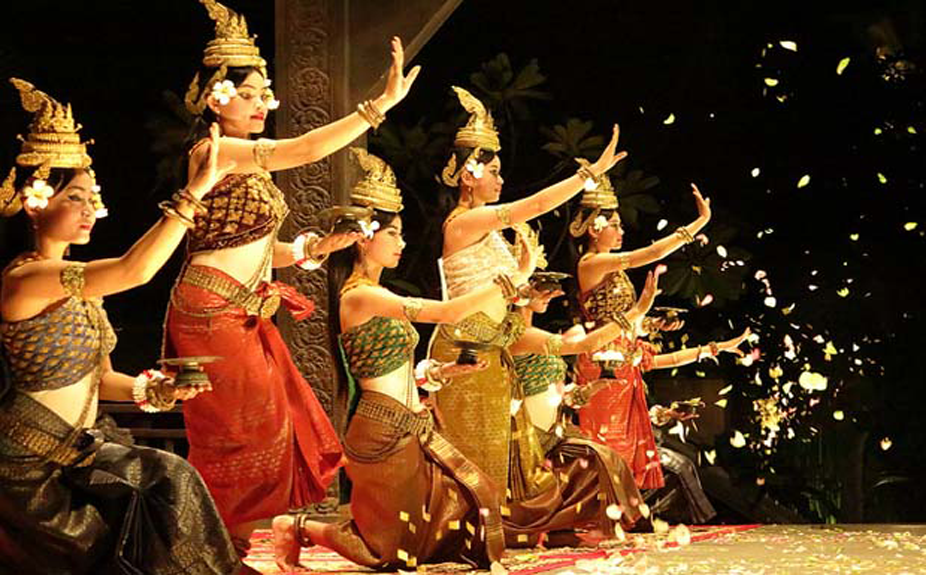Apsara Dance Performance
 Apsara Dance has been part of Khmer culture for centuries. This fact is evident from thousands of bas-reliefs found on the walls of ancient Angkorian and pre-Angkorian temples. In Hindu and Buddhist mythology you will often hear about a female spirit (a nymph-like creature), known as an Apsara that rules the clouds and waters. What makes the Apsara special is that they are always dancing and across Angkorian temples in Cambodia you can observe stone carvings of them.
Apsara Dance has been part of Khmer culture for centuries. This fact is evident from thousands of bas-reliefs found on the walls of ancient Angkorian and pre-Angkorian temples. In Hindu and Buddhist mythology you will often hear about a female spirit (a nymph-like creature), known as an Apsara that rules the clouds and waters. What makes the Apsara special is that they are always dancing and across Angkorian temples in Cambodia you can observe stone carvings of them.
Apsara has its origin from Sankrit language, meaning a female spirit of the clouds and waters in Hindu and Buddhist mythology. Apsaras are beautiful, supernatural female beings. They are youthful and elegant, and superb in the art of dancing. They are often the wives of the Gandharvas, the court musicians of Indra. They dance to the music made by the Gandharvas, usually in the palaces of the gods, entertain and sometimes seduce gods and men. As ethereal beings who inhabit the skies, and are often depicted taking flight, or at service of a god, they may be compared to angels.
Apsara dance is a form of Cambodian classical dance, popularly known as Cambodian Royal Ballet. It makes an integral part of Khmer culture and Khmer civilization. No trip to Cambodia would be complete without attending
an “Apsara Performance Dinner Show” which showcases the most famous pieces of Cambodian classical theatre. The apsara is performed by a woman, sewn into striking traditional dress, whose graceful, sinuous gestures are codified to narrate classical myths or religious stories. The costume of the apsara role is based on the devatas as depicted on bas-relief of Angkor Wat. They wear a sampot sarabap, a type of silk brocade that is intricately pleated in the front.
This art form suggests that Apsara dancers were not mere ritual performers that entertained people during the Angkorian period. They were also believed to have been the messengers to divinities. Estimates are that there were 3,000 Apsara dancers in the 12th century court of King Jayavarman VII.
Over the centuries Khmer dancing lent its influence to the classical ballet of neighboring countries, and some of its postures and movements are similar to other Southeast Asian dance forms. The Khmer kingdom started its traditions in the 8th century, 500 years before Thailand. In 1400, with the sacking of the Angkor Empire, the Apsara dancers were seized and taken to Thailand.
Apsara dancing is one of two elements of classical ballet, the other being "today" dancing and the depiction of early myths. Many of the dances involve performing a fragment of the Ramayana, the ancient Indian epic that is one and a half times as long as the Odyssey. Others are based on the legendary battles and mythical sagas carved in bas relief on the walls of the temples of Angkor-including the Churning of the Sea of Milk, the great battle between gods and demons for the holy liquid that gives immortality.